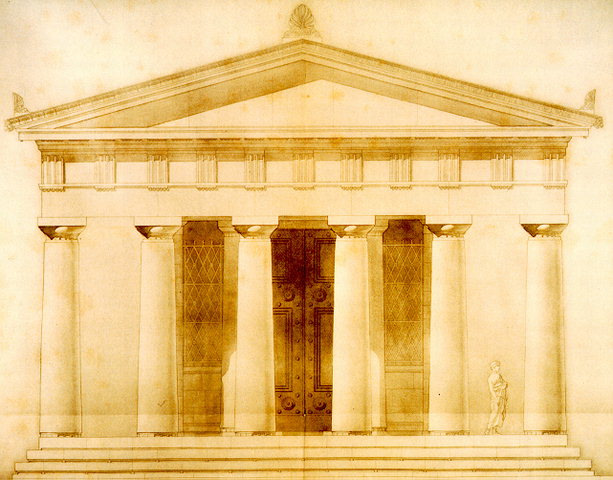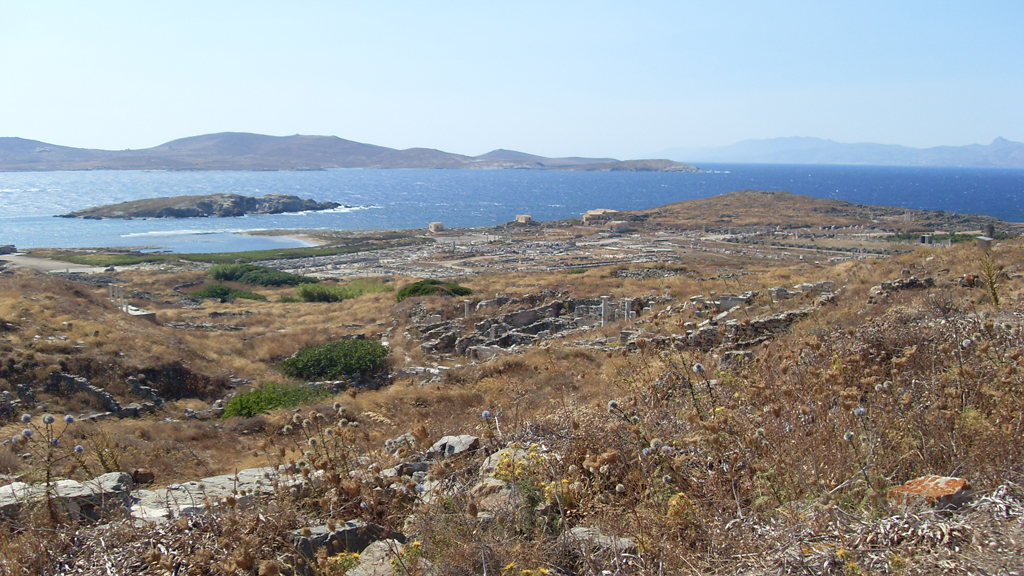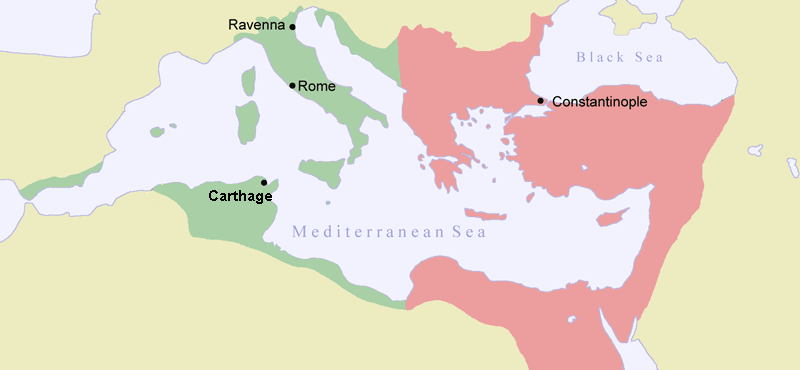|
Prasiae (Attica)
Prasiae or Prasiai ( grc, Πρασίαι) was a deme of ancient Attica on the east coast, between Potamus and Steiria, with an excellent harbour, from which the Theoria or sacred procession used to sail. Here was a temple of Apollo, and also the tomb of Erysichthon of Attica, who died at this place on his return from Delos. The ruins of the deme are seen on the north-east side of the bay. The harbour, now called Porto Rafti, is the best on the eastern coast of Attica, and is both deep and capacious. The entrance of the harbour is more than a mile in breadth; and in the centre of the entrance there is a rocky islet, upon which is a colossal statue of white marble, from which the harbour has derived its modem name, since it is commonly supposed to bear some resemblance to a tailor (ῥάφτης) at work. The statue evidently belongs to the Roman period, and probably to the first or second century after the Christian era. In the middle of the bay there is a rocky promontory with ru ... [...More Info...] [...Related Items...] OR: [Wikipedia] [Google] [Baidu] |
Deme
In Ancient Greece, a deme or ( grc, δῆμος, plural: demoi, δημοι) was a suburb or a subdivision of Classical Athens, Athens and other city-states. Demes as simple subdivisions of land in the countryside seem to have existed in the 6th century BC and earlier, but did not acquire particular significance until the reforms of Cleisthenes in 508 BC. In those reforms, enrollment in the citizen-lists of a deme became the requirement for citizenship; prior to that time, citizenship had been based on membership in a phratry, or family group. At this same time, demes were established in the main city of Athens itself, where they had not previously existed; in all, at the end of Cleisthenes' reforms, Classical Athens, Athens was divided into 139 demes, to which one can be added Berenikidai (established in 224/223 BC), Apollonieis (201/200 BC), and Antinoeis (added in 126/127). The establishment of demes as the fundamental units of the state weakened the ''genos, gene'', or aristo ... [...More Info...] [...Related Items...] OR: [Wikipedia] [Google] [Baidu] |
Potamus (Attica)
Potamus or Potamos ( grc, Ποταμός) was the name of several ''demoi'' of ancient Attica. They lay on the east coast north of Thoricus, and were once a populous place: they were celebrated as containing the sepulchre of Ion. The port of Potamus was probably the one which received the Peloponnesian fleet in 411 BCE. The demoi were: Potamus Deiradiotes, Potamus Hypenerthen, and Potamus Kathyperthen Upper Potamus, or Potamus Kathyperthen or Potamos Kathyperthen ( grc, Ποταμός καθύπερθεν), was a deme of ancient Attica. It lay on the east coast north of Thoricus, and was once a populous place: it was celebrated as containing the .... References Populated places in ancient Attica Former populated places in Greece Demoi {{AncientAttica-geo-stub ... [...More Info...] [...Related Items...] OR: [Wikipedia] [Google] [Baidu] |
Steiria (Attica)
Steiria ( grc, Στείρια) was a deme of ancient Attica on the east coast, between Prasiae and Brauron. Stiris in Phocis is said to have been founded by the inhabitants of this deme. The road from Attica to Steiria and the harbour of Prasiae was called the Στειριακὴ ὁδός. Steiria was the deme of Theramenes and Thrasybulus. Steiria is located west of Porto Rafti. People *Theramenes (d. 404 BCE), Athenian statesman *Thrasybulus Thrasybulus (; grc-gre, Θρασύβουλος ; 440 – 388 BC) was an Athenian general and democratic leader. In 411 BC, in the wake of an oligarchic coup at Athens, the pro-democracy sailors at Samos elected him as a general, making him ... (), Athenian general References Populated places in ancient Attica Former populated places in Greece Demoi {{AncientAttica-geo-stub ... [...More Info...] [...Related Items...] OR: [Wikipedia] [Google] [Baidu] |
Apollo
Apollo, grc, Ἀπόλλωνος, Apóllōnos, label=genitive , ; , grc-dor, Ἀπέλλων, Apéllōn, ; grc, Ἀπείλων, Apeílōn, label=Arcadocypriot Greek, ; grc-aeo, Ἄπλουν, Áploun, la, Apollō, la, Apollinis, label=genitive, , ; , is one of the Twelve Olympians, Olympian deities in Ancient Greek religion, classical Greek and Ancient Roman religion, Roman religion and Greek mythology, Greek and Roman mythology. The national divinity of the Greeks, Apollo has been recognized as a god of archery, music and dance, truth and prophecy, healing and diseases, the Sun and light, poetry, and more. One of the most important and complex of the Greek gods, he is the son of Zeus and Leto, and the twin brother of Artemis, goddess of the hunt. Seen as the most beautiful god and the ideal of the ''kouros'' (ephebe, or a beardless, athletic youth), Apollo is considered to be the most Greek of all the gods. Apollo is known in Greek-influenced Etruscan mythology as ' ... [...More Info...] [...Related Items...] OR: [Wikipedia] [Google] [Baidu] |
Erysichthon Of Attica
In Greek mythology, Erysichthon (Ancient Greek: Ἐρυσίχθων), also spelled Erisichthon (lit. 'Earth-tearer') was an Athenian prince as the son of King Cecrops I of Athens and Agraulus, daughter of King Actaeus. His possible sibling were Aglaurus, Herse and Pandorus. Erysicthon died childless during his father's reign. Mythology Erysichthon was said to have died in Prasiae (modern Porto Rafti), on the east coast of Attica, as he was returning from the holy island of Delos with a statue of Eileithuia, goddess of childbirth. Of the three ancient wooden images of the goddess that could be seen at her temple at Athens, one was identified as the image that Erysichthon had brought from Delos. According to Pausanias, Erysichthon's tomb could be seen at Prasiae, where his corpse was said to have been buried after his ship had arrived in port.Pausanias1.2.6 Notes Princes in Greek mythology References * Apollodorus, ''The Library'' with an English Translation by Sir J ... [...More Info...] [...Related Items...] OR: [Wikipedia] [Google] [Baidu] |
Delos
The island of Delos (; el, Δήλος ; Attic: , Doric: ), near Mykonos, near the centre of the Cyclades archipelago, is one of the most important mythological, historical, and archaeological sites in Greece. The excavations in the island are among the most extensive in the Mediterranean; ongoing work takes place under the direction of the Ephorate of Antiquities of Cyclades, and many of the artifacts found are on display at the Archaeological Museum of Delos and the National Archaeological Museum of Athens. Delos had a position as a holy sanctuary for a millennium before Olympian Greek mythology made it the birthplace of Apollo and Artemis. From its Sacred Harbour, the horizon shows the three conical mounds that have identified landscapes sacred to a goddess (it is predicted that the deity's name is Athena) - in other sites: one, retaining its Pre-Greek name Mount Cynthus, is crowned with a sanctuary of Zeus. In 1990, UNESCO inscribed Delos on the World Heritage ... [...More Info...] [...Related Items...] OR: [Wikipedia] [Google] [Baidu] |
Roman Greece
Greece in the Roman era describes the Roman conquest of Greece, as well as the period of Greek history when Greece was dominated first by the Roman Republic and then by the Roman Empire. The Roman era of Greek history began with the Corinthian defeat in the Battle of Corinth in 146 BC. However, before the Achaean War, the Roman Republic had been steadily gaining control of mainland Greece by defeating the Kingdom of Macedon in a series of conflicts known as the Macedonian Wars. The Fourth Macedonian War ended at the Battle of Pydna in 148 BC with the defeat of the Macedonian royal pretender Andriscus. The definitive Roman occupation of the Greek world was established after the Battle of Actium (31 BC), in which Augustus defeated Cleopatra VII, the Greek Ptolemaic queen of Egypt, and the Roman general Mark Antony, and afterwards conquered Alexandria (30 BC), the last great city of Hellenistic Egypt. The Roman era of Greek history continued with Emperor Constantine the ... [...More Info...] [...Related Items...] OR: [Wikipedia] [Google] [Baidu] |
Ludwig Ross
Ludwig Ross (22 July 1806, Bornhöved – 6 August 1859, Halle an der Saale) was a German classical archaeologist. He is chiefly remembered for the rediscovery and reconstruction of the Temple of Athena Nike in 1835–1836, and for his other excavation and conservation work on the Acropolis of Athens. He was also a significant figure in the early years of archaeology in the independent Kingdom of Greece, serving as Ephor General of Antiquities between 1834 and 1836. As a representative of the ''Bavarocracy —'' the dominance by northern Europeans, especially Bavarians, of Greek government and institutions under the Bavarian-born King Otto ''—'' Ross attracted the enmity of the native Greek archaeological establishment. He was forced to resign as Ephor General over his delivery of the Athenian 'naval records', a series of inscriptions first unearthed in 1834, to the German August Böckh for publication. He was subsequently appointed as the first professor of archaeology at ... [...More Info...] [...Related Items...] OR: [Wikipedia] [Google] [Baidu] |
Coroneia (promontory)
Koroneia ( el, Κορώνεια, before 1915: Κουτουμουλάς - ''Koutoumoulas'') is a village and a former municipality in Boeotia, Greece. Since the 2011 local government reform it is part of the municipality Livadeia, of which it is a municipal unit. The population of the municipal unit was 3,170 at the 2011 census.Detailed census results 2011 Geography The municipal unit Koroneia consists of the following communities: Agios Georgios (the seat of the former municipality), Agia Anna, Agia Triada, Alalkomenes and Koroneia. ...[...More Info...] [...Related Items...] OR: [Wikipedia] [Google] [Baidu] |
Stephanus Of Byzantium
Stephanus or Stephan of Byzantium ( la, Stephanus Byzantinus; grc-gre, Στέφανος Βυζάντιος, ''Stéphanos Byzántios''; centuryAD), was a Byzantine grammarian and the author of an important geographical dictionary entitled ''Ethnica'' (). Only meagre fragments of the dictionary survive, but the epitome is extant, compiled by one Hermolaus, not otherwise identified. Life Nothing is known about the life of Stephanus, except that he was a Greek grammarian who was active in Constantinople, and lived after the time of Arcadius and Honorius, and before that of Justinian II. Later writers provide no information about him, but they do note that the work was later reduced to an epitome by a certain Hermolaus, who dedicated his epitome to Justinian; whether the first or second emperor of that name is meant is disputed, but it seems probable that Stephanus flourished in Byzantium in the earlier part of the sixth century AD, under Justinian I. The ''Ethnica'' Even as a ... [...More Info...] [...Related Items...] OR: [Wikipedia] [Google] [Baidu] |




